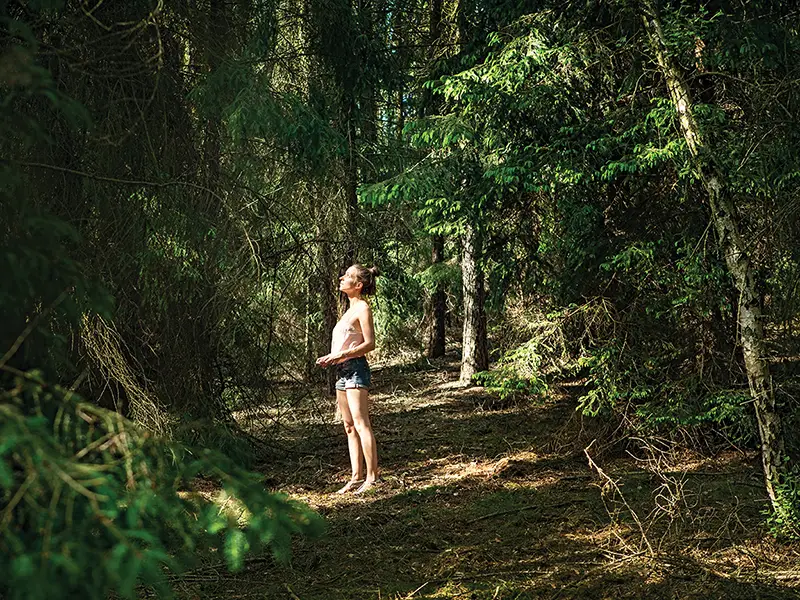Can you remember the last time you took a nature walk without your phone or camera? If you’re like most of the Western world, the answer is probably not. Studies have found that Americans spend a whopping 93 percent of their time indoors or in a vehicle — and not without health problems to show for it.
Forest bathing, also known as Shinrin-yoku in Japanese, allows participants to reap numerous physical and mental benefits, such as a boosted immune system, better sleep and less stress. With between 40 and 60 percent of college students suffering from anxiety, forest bathing could be a helpful stress buster.
Unlike a hike or a standard nature walk, participants don’t worry about pace, distance or specific goals. Instead, forest bathing consists of roaming around, engaging the senses and restoratively connecting with nature.
Brief History
The term forest bathing was coined in 1982 by the Japanese Ministry of Agriculture. Proponents believed forest bathing to be a useful tool in the toolbox of healthcare. Now, there are 44 approved forest bathing locations in Japan.
Intrinsically, most people know being outside is good for their health, but the myriad benefits of doing so are still relatively unknown. Luckily, this is starting to change in the United States, where forest bathing is a rising trend, much like yoga was 30 years ago.
In 2012, M. Amos Clifford (whose recent book focuses on the meditative aspects of forest bathing) founded the Association of Nature & Forest Therapy, an organization that certifies forest therapy guides. Clifford hopes nature therapy will eventually be reimbursed by healthcare professionals.
The Scientific Benefits
The act of wandering through foliage is enough to ease tension; in fact, scientific studies have highlighted the numerous medical benefits of forest bathing. Most Americans are frequently bombarded with toxins, whether they live in cities or not. Indoor pollutants include, but are not limited to, mold, smoke and cleaning chemicals. For starters, it’s recommended to keep house plants to purify the air.
Trees and other vegetation secrete antimicrobial organic compounds called phytonicides — also known as the aroma of the forest — in order to ward off insects and other pests. These chemicals, combined with the overall serenity of forest bathing, have been shown to lower cortisol (the stress hormone) and blood pressure, as well as boost the immune system and improve mental health and memory. Forest bathing has even been shown to boost creativity.
Evergreens release a chemical that particularly improves the immune system. In the 1800s, German doctors set up sanatoriums in pine forests to treat tuberculosis patients. The location appeared to yield better results, prompting some physicians to believe the trees were releasing a healing balm. So next time you’re picking out a Christmas tree, take your time and breathe deeply.
How to Get Started
If you don’t readily have access to a forest, don’t despair. Public parks and backyards make terrific places to connect with flora.
In order to successfully indulge in nature therapy, you must employ your five senses. An example would be meandering around, touching the rough bark of a tree or lightly stroking a velvety flower petal while inhaling the scent of rain. Or, perhaps tuning in to the sweet chirp of a cardinal. Some people will even go so far as to taste flower petals.

An important facet of forest bathing is reciprocity, explains Clifford in a blog post. You can mindfully thank the tree you touch for providing you with shade and beneficial compounds, and in return provide the tree with a song or gesture. This may be too far out there for certain forest bathers, but the point is that it’s important to think of nature as more than just a resource to be utilized for the sake of human wellness.
Some people may find it restorative to read nature poetry, either silently or out loud. I recommend American poet Mary Oliver — in particular, her poem “Sleeping in the Forest.”
Forest bathing can be done individually or with a certified local forest therapy guide, who can usually host public or private sessions. After perusing the Association of Nature and Forest Therapy website, I found out my local forest therapy guide leads participants through the woods, prompting them to engage their senses while allowing time for individual reflection as well — he also provides warm tea at the destination. And yes, I’m absolutely going to sign up for the autumnal stroll occurring in a couple of months.
Whether you’re a stressed out college student who needs a break from last minute studying for finals (and crying) or anyone else, there’s no reason not to bathe in some forests. Just put the smartphone down, take a deep breath and step outside.
As prominent naturalist John Muir said, “In every walk with nature, one receives far more than he seeks.”

















